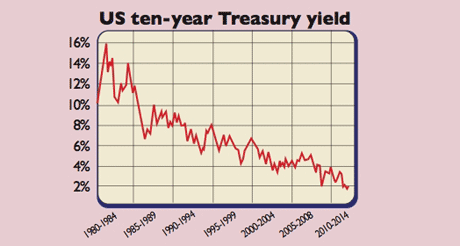
The end of the multi-decade government-bond bull market in the Western world “has been proclaimed more times than supposed sightings of Elvis”, says Richard Milne in the FT. Yet over the past few years, bond yields have ground ever lower (reflecting rising prices, as these move inversely to yields). Germany, America and Britain have all been able to borrow ten-year money at historically rock-bottom interest rates of under 2% in recent years.
However, many observers now think that the long-term trend has finally turned. Rapid recent upticks in yields mean that “a long-term bear market [in bonds] has commenced”, says UBS. Last September’s US ten-year Treasury low of 1.72% will come to be seen as the turning point, according to analysts at the Swiss investment bank. They also warn just how quickly bond yields can rise; in 1994, yields jumped from 5% to 8% in a year as prices tanked.
If the long-term trend has turned, it would certainly fit the historical pattern. A study by Longview Economics shows that Treasury bonds spent an average of 30 years in their last three cycles. Sure enough, the latest bond bull started in the early 1980s, when Fed chairman Paul Volcker squeezed out inflation by raising interest rates.
We’ve been here before…
Then again, as Howard Simons of Bianco Research puts it, “how many of these rising rate scares have we had in the past 30 years”? Yields spiked in early 2010 and 2011, notes Ben Levisohn in The Wall Street Journal. Then, as now, people bet that the economy had turned the corner, reducing the appeal of traditional safe havens such as bonds. But that came to naught.
It could be a similar story this time. America looks stronger, but it’s too soon to say whether the upswing is self-sustaining. The Fed this week indicated that it thought it would have to support the economy for some time. The eurozone crisis is flaring up again and China is weakening. So it’s not too hard to envisage a scenario of yields falling again, if not back to their multi-decade lows.
Note too that yields are capped to some extent because central banks have bought so many bonds with printed money. If the economy improves, yields could rise quickly, implying a sharp jump in borrowing costs for households and companies, says Milne. Central banks would then be inclined to print more money and buy more bonds, bringing borrowing costs down again, rather than watch a fragile recovery peter out. Similarly, they are unlikely to ditch their bonds quickly as times improve for fear of causing a sharp jump in yields.
… but now inflation is on the rise too
Nonetheless, inflation expectations are rising, as M&G Investments points out on Bondvigilantes.com. Break-even inflation rates – the gap between the yield on index-linked bonds and conventional bonds – are one measure of expected inflation, and they are heading higher. No wonder.
The danger is that all the printed money injected into economies will eventually cause a sharp jump in prices once the speed at which money moves around the economy (its “velocity”) regains pre-crisis rates. Inflation is already “significantly above target in [Europe, the UK and the US], and yet policy is not only not being tightened, the taps are still very much on”. Inflation rapidly erodes the fixed payouts on bonds and sends prices lower.
The upshot is that bond yields may well have seen their lows. But central banks will try to ensure yields don’t rocket, so they could spend years at current levels. Note that in the 1940s there was an eight-year period of yields around these levels, says Buttonwood in The Economist. With inflation rates in many cases still quite a lot higher than yields, bonds remain unattractive.